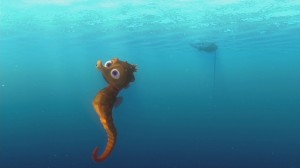What is a Hippocampus? It is Latin for Sea horse – hippo meaning horse and kampos meaning sea monster. Not a creature people talk about too often. Why don’t we discuss this sea creature a little!
Collectively, in the world, there are almost fifty different types of this species and plenty of “sub-species”. Scientists find difficulty in distinguishing all the sea horse species because “individuals of the same species can vary greatly in appearance and new species continue to be found.” The sea horses tend to live in the weed-like components of the sea. These creatures are known to “eat small crustacea such as Mysis Shrimp. An adult eats 30-50 times a day. Sea horse fry (baby sea horses) eat a staggering 3000 pieces of food per day.” Although, these fish lack teeth and a stomach therefore, “food passes through their digestive systems so quickly, they must eat almost constantly to stay alive.” The snouts are able to stretch and expand. When the seahorse needs to reach into a tight area is when it will stretch its snout. Expansion is done if the “prey is larger than the snout.”
So we talked about a couple aspects of their bodies, let’s continue. Like most sea creatures, sea horse’s eyes are independent from each other. This is very useful with predators and prey. “Unlike most other fish, sea horses have an exo-skeleton. Their bodies are made up of hard, external, bony plates that are fused together with a fleshy covering. They do not have scales.” They all have prehensile tails ,which help in “strong currents and waves.” Sea horses cannot swim well, so “they rely on their dorsal fin.” This fin will beat between “30-70 times per second.” Pectoral fins either side of the head help with stability and steering.
Speaking of ‘swimming away’… how do these fish avoid predators? Well, it is not easy due to their size and swimming abilities. Although sea horses do have some tricks! Like chameleons, these creatures are able to use surrounding colors to camouflage themselves. “They have even been known to turn bright red to match floating debris.” Aside from threats in the water – there are also forms of threat from humans. There are three main actions humans will perform that hard the sea horses. These being:
- “The Traditional Chinese Medicine Trade takes in excess of up to 150 million seahorses a year from the wild and these are used for all types of medicine.
- The Curio Trade takes approximately one million seahorses from the wild. Along with shells and starfish; they are deliberately taken from the sea and left to die in the boiling sun. They are then sold as souvenirs, sad and sorrowful reminder of once beautiful creatures.
- The pet trade takes an estimated one million seahorses from the wild and It is thought that less than 1,000 survive more than six weeks, very often suffering a slow and possibly painful death.”
When one sea horse dies, I wonder if their partner will know? Most likely. This is due to the fact that “sea horses pair for life.” Each morning the pair will “reinforce their pair bonding with an elaborate courtship display.” How does this work? “The female meets the male in his territory and as they approach each other, they change colour. The male circles around the female and the pair often spiral around an object.” The courtship display may last “unto an hour.”
Now what usually comes after a marriage? Babies! Except it is a little different of a process with sea horses. The female sea horse’s eggs transfer to the male where he fertilizes each in his pouch. Small species can have between 50-150 eggs and larger species, up to 1,500. Their gestation period can be from “fourteen to four weeks” long. The actual birthing can take a while with “contractions lasting unto 12 hours.”
A sea horse’s birthing process – video
Those babies are completely on their own once born. “The first two to three weeks of their lives” are spent “drifting along in the plankton layer of the ocean.” Unfortunately, “less than one in a thousand will survive long enough to become an adult due to predators.” If not predators, I am sure the size of sea horses does not help in survival because the currents can become unbearable.
Sea horses are just little creatures that people sometimes forget about them I always found their way of life to be quite interesting. I hope you gained some new information and fun facts on our horse-like sea monsters!

